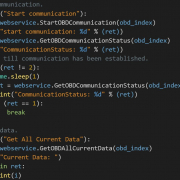Fernsteuerung von DiagRA D und Silver Scan-Tool über die optionale Webservices-API
Immer mehr Nutzer von DiagRA D und Silver Scan-Tool nutzen die Fernsteuermöglichkeit über die Webservices API. Über die Schnittstelle können externe Anwendungen auf demselben Rechner oder im lokalen Netzwerk nahezu die komplette Funktionalität der beiden Anwendungen nutzen. So lassen sich beispielsweise über ein Python-Skript Flash-Abläufe mit anschließenden Diagnosetests automatisieren oder ganz gezielt spezielle Diagnosetests an HiLs oder Prüfständen in die Experimente integrieren. Natürlich können auch immer wiederkehrende OBD-Tests sehr einfach automatisiert werden.
Technischer Hintergrund: Das Interface der Web Services wird dabei durch ein maschinell verarbeitbares Format gegeben, typischerweise durch WSDL (Web Services Description Language). Dabei wird das Netzwerkprotokoll SOAP (Simple Object Access Protocol) zur Kommunikation verwendet. Hierbei wird XML als Nachrichtenformat und das HTTP-Protokoll zur Kommunikation innerhalb des Netzwerks verwendet. Im Fall von DiagRA D/Silver Scan-Tool findet die Kommunikation zwischen einem Client-Programm und DiagRA D/Silver Scan-Tool statt, wobei DiagRA D/Silver Scan-Tool als Server-Anwendung dient. Die Webservices sind als API für SOAP implementiert, sodass der Nutzer sich weder um die Erstellung der XML-Nachrichten noch die HTTP-Kommunikation kümmern muss.
Das untenstehende Beispiel zeigt, wie mittels Python-Skript über DiagRA D erst die Kommunikation eingeleitet, dann von allen OBD-Steuergeräten alle Werte vom Mode $01, dann gezielt die Steuergeräteversorgungsspannung PID $42 und im Anschluss noch der MIL Status aus dem Mode $03 ausgelesen wird. Zum Abschluss wird die Kommunikation mit dem OBD-System wieder beendet. Als SOAP Client kommt im Beispiel ZEEP zum Einsatz. Eine Dokumentation der Kommandos findet sich direkt in bestehenden Installationen von DiagRA D oder Silver Scan-Tool im Ordner Samples.
Das Webservices-Plugin ist eine optionale Erweiterung einer DiagRA D oder Silver Scan-Tool Lizenz und kann entweder mit einer Lizenz mitbestellt oder nachträglich hinzugefügt werden.
Bei Interesse kontaktieren Sie uns bitte über info@rac.de.
Beispiel Python-Skript:
#!/usr/bin/python3
# -*- coding: utf-8 -*-
import sys
import time
# PLEASE NOTE:
# This script uses the third party package Zeep ("A fast and modern Python SOAP client").
# Find Zeep in the Python package index: https://pypi.org/project/zeep/
# Find its documentation here: https://docs.python-zeep.org/en/master/
# Should you be interested in logging, this might help you: https://docs.python-zeep.org/en/master/plugins.html
# Zeep project and sources on GitHub: https://github.com/mvantellingen/python-zeep
from zeep import Client, Transport, __version__ as zeep_version
# Configure web service connection.
# PLEASE NOTE:
# If web service is not running on local machine (localhost/127.0.0.1),
# you will have to call the login method at first, before being able to use any other method.
IP_ADDRESS = "localhost"
PORT = 1024
# Set 'INTRANET_ONLY', if an internet connection is not available.
# PLEASE NOTE:
# This requires the 'soapencoding.xsd' to reside in './resources' subfolder.
# It can be downloaded, here: http://schemas.xmlsoap.org/soap/encoding/
INTRANET_ONLY = False
# Web service constants
RETURN_CODE_SUCCESS = 0
COMMUNICATION_STARTED = 0
COMMUNICATION_STOPPED = 1
COMMUNICATION_ESTABLISHED = 2
class TransportIntranetOnly(Transport):
def load(self, url):
# See https://stackoverflow.com/a/40280341
if (url == "http://schemas.xmlsoap.org/soap/encoding/"):
url = "resources/soapencoding.xsd"
# print(url)
return super(TransportIntranetOnly, self).load(url)
def wait_for_communication(get_status):
result = False
while True:
communication_status = get_status()
print(f"Communication status: {communication_status}")
if (communication_status == COMMUNICATION_ESTABLISHED):
result = True
break
# Also leave loop if communcation has unexpectedly been stopped.
if (communication_status == COMMUNICATION_STOPPED):
print("Communication has been stopped.")
break
time.sleep(1) # Wait before next poll.
return result
def main(intranetonly):
print("Web service OBD sample | RA Consulting GmbH 2021 | www.rac.de")
print("")
# PLEASE NOTE:
# DiagRA D or Silver Scan-Tool needs to be running and web service needs to be activated.
wsdl = f"http://{IP_ADDRESS}:{PORT}/wsdl/IDiagRAWebservice"
if intranetonly:
client = Client(wsdl, transport=TransportIntranetOnly())
else:
client = Client(wsdl)
webservice = client.service
# factory = client.type_factory("ns0") # Needed to handle non-primitive argument and return types.
# Perform login.
# PLEASE NOTE:
# This is required if web service is not running on local machine (localhost/127.0.0.1).
# webservice.Login("Example python script")
try:
# Temporarily increase log level of the web service. Possible values are 1 to 7.
# The log file is very helpful if things don't work out as expected. It contains all the called methods, the given arguments, the results and the return codes.
# It is written to '%LocalAppData%\RA Consulting\DiagRA D\Log' or '%LocalAppData%\RA Consulting\Silver Scan-Tool\Log', respectively,
# and is called 'DiagRA_RemoteControl_*.log'.
# You can also set a permanent log level in the Windows registry. Have a look into DiagRA D's/Silver Scan-Tool's help file to find out how this is done.
webservice.Configure("LOGLEVEL", "5")
# Print versions.
webservice_version = webservice.GetVersion("")
print("Versions:")
print(f"- Python {sys.version}")
print(f"- Zeep {zeep_version}")
print(f"- Web service {webservice_version}")
print()
# Set addressword for OBD and obtain its index.
# PLEASE NOTE:
# If you like to communicate with a distinct ECU/addressword instead, you need to use 'GetECUIndex'
# and the web service's non-OBD methods (the ones not containing 'OBD' in their names).
# For a list of all available methods, see web service reference PDF that resides in
# subfolder '.\Samples\WebServices\Doc' of the installation directory.
obd_index = webservice.GetOBDIndex("33", "")
print(f"OBD index: {obd_index}")
if (obd_index < RETURN_CODE_SUCCESS):
print(webservice.GetLastErrorText())
else:
# OBD addressword has been successfully set.
# Now set protocol.
webservice.Configure("PROTOCOL", "ISO 15765-4 (CAN)")
# Try to start communication.
return_code = webservice.StartOBDCommunication(obd_index)
print(f"Start communication: {return_code}")
if (return_code == RETURN_CODE_SUCCESS):
# Communication could be started.
try:
# Wait until communication has fully been established, before requesting data.
communication_established = wait_for_communication(lambda: webservice.GetOBDCommunicationStatus(obd_index))
if communication_established:
# Read current data.
result = webservice.GetOBDAllCurrentData(obd_index)
print("Current Data: ")
for item in result:
print(item)
# Read module voltage.
result = webservice.GetOBDSingleCurrentData(obd_index, "42")
print("Control Module Voltage: ")
for item in result:
print(item)
# Get MIL status.
result = webservice.GetOBDMILStatus(obd_index)
print("Mode 3: ")
for item in result:
print(item)
finally:
# Stop communication.
return_code = webservice.StopOBDCommunication(obd_index)
print(f"Stop communication: {return_code}")
finally:
# Perform logout.
# webservice.Logout()
pass
if (__name__ == "__main__"):
main(INTRANET_ONLY)


